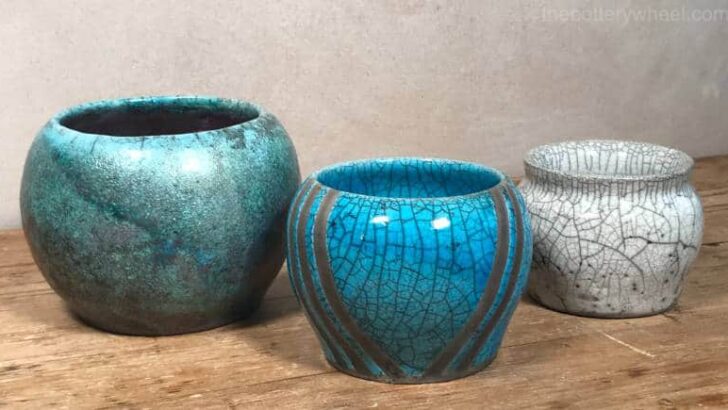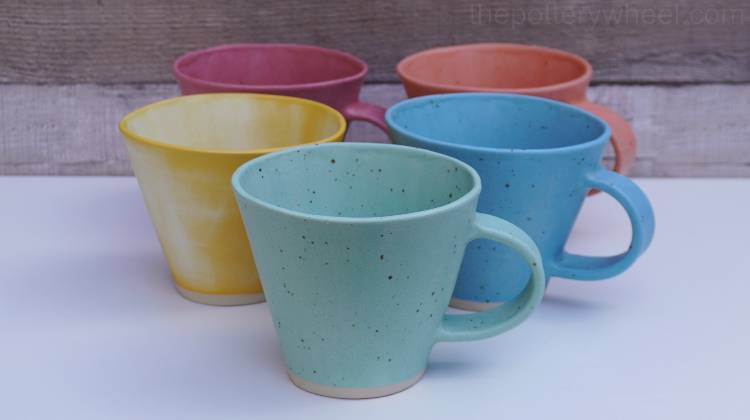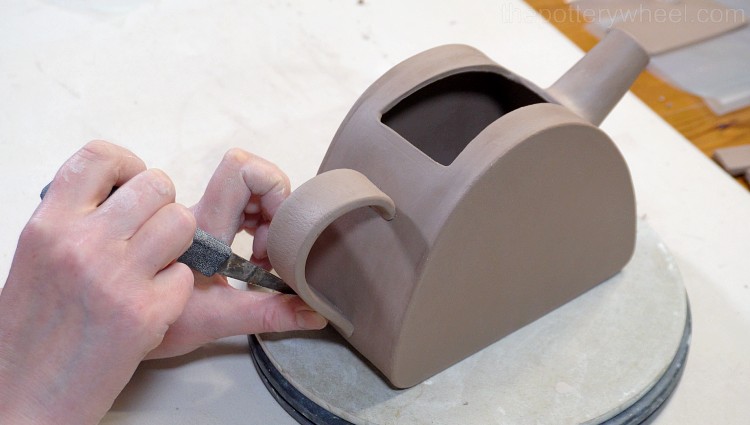Raku pottery can look lovely. However, it is porous and fragile. The question of whether raku is waterproof has been debated for a long time. There has been much debate around whether can raku be food-safe. This article looks at these issues and considers whether there are effective ways to seal raku pottery.
There are products that can be applied to raku to make it water-resistant. And some potters use glazing techniques to try to make it suitable for dinnerware. So, there are ways to seal raku to an extent. However, it’s generally accepted that raku is decorative rather than functional.
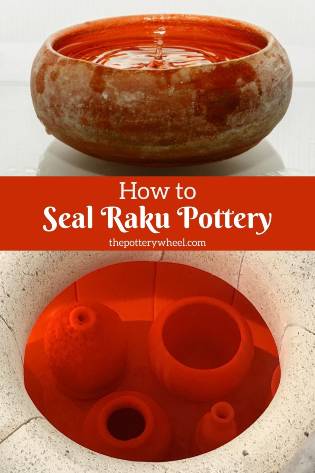
How to Seal Raku Pottery
There are a few reasons why potters may want to seal their raku pottery. Some of these reasons might be:
- Protecting your ware and preserving the look of your raku surface
- Making the raku pottery waterproof so it can be used as a vessel like a vase
- Trying to make the raku pottery food safe and functional as dinnerware
Let’s look at each of these different reasons in turn, and consider what can be achieved and how.
Why Might Raku Pottery Need to be Sealed?
The raku firing process is quick and low fire. A raku firing can take anything between 30 and 90 minutes. This is a lot less than a regular kiln firing, be it gas or electric. It can take between 8 and 12 hours to glaze fire pottery in an electric kiln.
Because raku is fired for a shorter period at a lower temperature, the ceramics and glaze are not fully mature. The clay is still porous. This means it absorbs liquid and it is not especially strong or durable. As a result, raku pottery is unsuitable for being a water-holding vessel like a vase.
Why is Raku Pottery Not Suitable as Dinnerware?
Because the raku ceramic and glaze are not strong, they chip and break easily. This makes them unsuitable as dinnerware.
Also, the surface of raku pottery is generally crazed and cracked. The reason for this is that it undergoes sudden temperature changes when it is being fired.
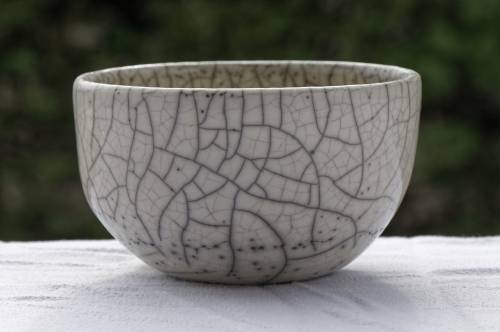
The crazing on raku pottery is an intentional design effect. However, it does mean it is not suitable as dinnerware. Liquid can seep into the cracks, and bacteria can harbor in them too.
There are another couple of reasons why raku pottery is not suitable as dinnerware:
Firstly, many raku glazes contain metal oxides such as lead and cadmium. These are that are toxic if consumed. Toxins are known to leach out of ceramic surfaces and make them unsuitable for food consumption.
Secondly, dinnerware requires constant washing and the delicate nature of raku finish does not cope well with this. Raku glaze chips and flakes easily. Not only is it not safe to have flakes of glaze in your food, but it also ruins the pottery too.
So, all in all, this creates a reasonably watertight case for raku not being watertight. Or does it? Here are some methods that potters use to seal raku pottery.
How to Seal Raku Pottery – Protecting the Surface of Your Raku:
The technique you use to seal raku pottery depends upon what you are protecting it from.
Protecting your Raku From The Elements
Air / Oxygen
Some potters notice that certain raku glazes will lose their luster over time. Glazes with a metallic content are more vulnerable to this. For example, glazes with a high percentage of copper may go green with time.
These changes in color are sometimes put down to re-oxidation of the metals in the glaze. Copper glaze can turn green because like any copper exposed to oxygen it develops a green patina.
One way to prevent this is to put a sealant on top of the glaze. Some potters recommend applying a brick or concrete sealant. These are designed to create a barrier between brick walls and the damp. But because they prevent water penetration, they also create an effective barrier to oxygen. A tile sealer would also work.
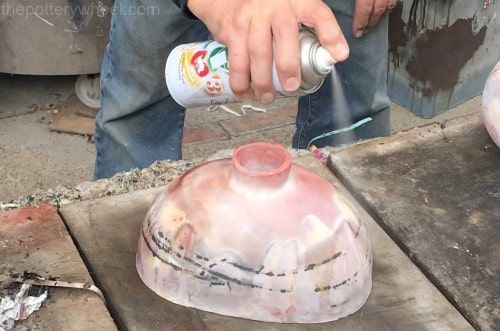
It’s not just metallic raku glazes that can lose their wow factor with time. Matte glazes also change color over time. One solution to this problem is to spray the glaze with a clear acrylic sealer.
The unglazed black areas on raku that have blackened due to carbonization during firing can lose their intensity with time.
A matte acrylic sealer will help them to stay a deep black for longer rather than fading.
Similarly, a gloss finish acrylic spray will protect glossy raku pottery from losing its luster too.
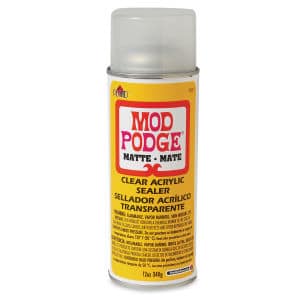
Clear Matte Acrylic Spray – View on Blick
Sun
Although raku is not especially weatherproof, it is used outside in the garden. Raku garden planters are popular as are wall plaques and outdoor decorations.
These items are vulnerable to fading as a result of exposure to UV light. Therefore, potters will recommend applying an acrylic sealant with a UV protector in it.
This will prevent colors and metallic hues in the glaze from fading in the sun. This acrylic spray by Krylon goes on clear, is suitable for ceramics, and protects from UV damage.
Protecting your Raku From Wear and Tear
Another reason why potters will seal raku pottery is to protect the relatively delicate glaze from chips and flaking. Potters are inventive, and there are many different ways to provide some level of seal on raku.
Two of the most popular ways are to apply either oil or wax. Another advantage of these is that they can also create an attractive sheen. Here are some suggestions for oils and waxes that can help seal raku pottery.
Oil
Sometimes potters recommend using Tung Oil on the inside of pots to make them water-resistant. It can also be used to seal and enhance colors on the outside of pottery.
Tung oil hardens when it is applied. So, it creates a hard, protective surface. It can have a glossy wet-look finish. It is often marketed as being waterproof.
However, tung oil is most often use on wood. Most potters are cautious when it comes to claims that an oil produce can make raku waterproof. It may make a pot water-resistant.
Nevertheless, if you are thinking of using it for a vase, you would be wise to test it out. Otherwise, you might find a puddle of water on your coffee table in the morning.
Simple vegetable oils are also used on greenware before burnishing. Sunflower oil for example can be applied to leather hard or bone-dry clay and burnished to a high sheen. This creates a degree of protection and makes pottery water repellent. Though not waterproof.
Wax
Wax can also be used as a way to seal raku pottery. As with oil, the seal is not really sufficient to make it waterproof. However, it does provide some level of protection, water repellence, and an aesthetic sheen.
Potters variously use floor wax, antique restoring wax, furniture wax, and even clear shoe polish.
Floor waxes
Some of the floor waxes that are recommended by potters. One good example is Trewax Gold Label Wax.
Trewax Gold Label Sealer Wax is designed for vinyl and lino floors. However, it is used on wood, plaster, and to seal ceramics.
It has a gloss or satin finish, so that’s something to be aware of when applying to your pottery.
Antique and Craft Waxes
There are waxes on the market that are more specifically developed for arts and crafts purposes. If you aren’t happy using a floor polish to seal your raku, then you might want to try one of these.
Renaissance Wax Polish is used by museums and art galleries to polish and protect artifacts.
It’s a micro-crystalline wax polish, which means that, unlike paraffin wax, it is made up of very fine crystals.
Using it to seal raku pottery is simple. You simply apply it to the raku surface and then buff it with a cloth.
The mature wax is hard, so it does create a good barrier to spilled liquid and finger greasy prints. If your raku is burnished, then a thin layer is really all you need.
An alternative is Dover’s Clear Wax. Like Renaissance wax, it is simply applied and buffed off to create a soft sheen. However, unlike Renaissance Wax, Dover’s Wax doesn’t contain petroleum products. It is also a blend of natural ingredients, including beeswax and carnauba wax.
Dover’s Wax does not contain volatile organic compounds (VOCs) which have been linked to ill health. It smells good. And to top it all off, it’s low effort. It doesn’t take a lot of work to create a nice-looking finish. As well as being used on raku pottery, this is also used to seal and finish saggar and pit-fired pieces.
The number of waxes that potters use to seal raku pottery is very varied. And ultimately, it may just be a matter of experimenting to find which suits you and your raku ware.
Some potters like to go all-natural and use beeswax. Others use old-school furniture polish like Johnson’s Paste Wax.
Some potters use clear shoe polish to provide a protective barrier.
How to Seal Raku Pottery – Is Raku Pottery Waterproof?
The above suggestions are largely about protecting your raku and making it water repellent rather than waterproof. The question remains, can raku be made waterproof?
Well, the answer is, maybe…..
Some potters say the answer is basically no, you can’t make raku waterproof. The argument is that raku can be coated with various things that make it temporarily waterproof. However, with time the pottery will suffer from continual seepage and will eventually disintegrate.
One way to use raku as a vase is to put a smaller jar inside the raku ware. Effectively you are sliding a bottle or jar inside the pottery. This then holds the water and the flowers, but you get to enjoy your raku ware too.
However, there are potters who swear that you can make raku waterproof. Here are some of the ways that you can try….
- A satin polyurethane sealant. This can be poured into the raku vase, turned around to coat the entire surface, and then poured out. Two or more coats could be applied if necessary.
Thompson’s clear surface waterproofer. This is designed for porous surfaces like brick and concrete. - Try a two-part epoxy resin. Some of these are marine grade and used to repair boats, or alternatively, you could try an artist’s epoxy resin product.
- Liquid quartz – There is a product called Liquid Quartz, that is made by a company called Made of Australia. It is, indeed, made in Australia, but they do ship internationally.
Their marketing materials state that it will make unglazed ceramic surfaces such as saggar and raku waterproof. Sealing raku pottery vessels is done by pouring the liquid quartz into the vase. This is then left for around 20 seconds, and then the remaining liquid can be poured back into the container. - Yacht varnish
Some potters use these methods of trying to make raku waterproof. Others remain skeptical. If you are of the skeptical mindset, then perhaps you are better keeping your raku as purely decorative.
How to Seal Raku Pottery – Is Raku Pottery Food Safe?
The other question about how to seal raku pottery is whether it is possible to make it food safe. For most potter’s the answer to this question is a resounding ‘no!’ There is a consensus that lovely though it is, raku is simply not safe as dinnerware.
However, like everything, with all consensus there are dissenters. Here are a couple of methods put forward by optimistic potters who want to use their raku for dinnerware:
- Fire your potter three times. The first fire is the bisque fire. Then apply a food-safe glaze to the surface you want to eat from and fire to cone 5 or 6. Finally, raku fire to create the raku effect on the rest of your pottery.
Some potters report success with this approach. They acknowledge that there is a higher risk of the pottery breaking in the raku fire. However, if the ware survives the extremes of the raku fire, then the pottery may be food safe.
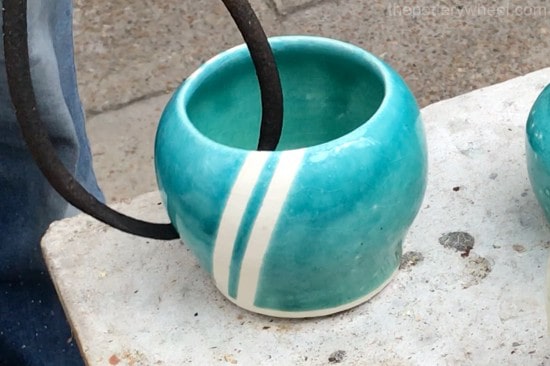
- You can buy some commercially produced raku glazes from manufacturers who consider them to be dinnerware safe.
However, for the most part, it is agreed that raku pottery is simply not food safe. Some potters will admit to using raku for serving up dry goods like chips, crackers, and pop-corn.
If you are using raku pottery to serve dry food, don’t wash your pottery over and over. Continual washing will ruin the raku finish and smoke patterns. Raku is never suitable for the rigors of the dishwasher.
Final Thoughts
The debate about whether raku can be made waterproof or food-safe is a long-standing one. This article has been an attempt to set out some of the ways potters try to seal raku pottery. Some of how you approach this issue will be a matter of trial and error and personal choice. I tend to err on the safe side and keep raku pottery for decorative purposes.

